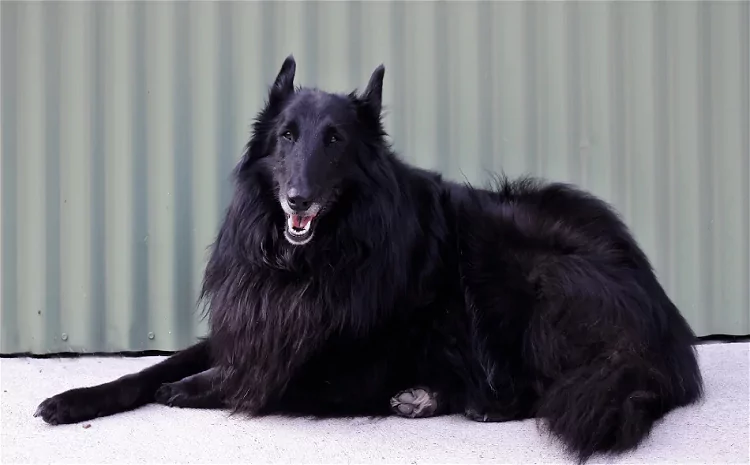
With their striking solid black coats and bold personalities, black Belgian malinois make quite an impression. These working dogs have risen in popularity in recent years due to their intelligence, trainability, and adaptability. But there is more to the breed than its color. Keep reading to learn everything you need to know about the black Belgian malinois.
Belgian malinois in general, including the black variety, are highly driven and energetic working dogs initially bred to be herding dogs. They excel today as police dogs, search and rescue dogs, detection dogs, and more. With proper training and an active lifestyle, they also make wonderful active family companions. Their popularity has skyrocketed in recent years.
As we dive deeper into this impressive breed, you’ll discover answers to common questions, including:
- What is the history behind the Belgian malinois breed?
- What are the differences between a black Belgian malinois vs. a fawn or mahogany colored one?
- What are Belgian malinois like as pets and what does it take to own one?
- How can you find a reputable breeder of black Belgian malinois puppies?
Learning these key things, and more, will help you determine if this eye-catching black dog could be the right breed for you.
Key Takeaways
- Black malinois have the same ancestry, talents and traits as traditionally colored belgian shepherd dog but with a rare recessive solid black coat instead of fawn with a black mask.
- Smart, energetic, athletic and assertive – this intense breed thrives with experienced active owners providing extensive daily exercise, training and jobs to do.
- Solid black and fawn Belgian malinois can appear randomly in the same litter since coat color is determined by recessive genes.
- Reputable ethical breeders focus on health, ability and temperament first, not unusual colors. Always confirm all recommended clearances.
What Is the History of Belgian Malinois Dogs?
Let’s start at the beginning with a quick history lesson. The versatile Belgian malinois breed traces its origins to Belgium in the late 1800s. Along with three other varieties – the Belgian Tervuren, Belgian sheepdog, and Belgian Laekenois – Belgian malinois are part of the Belgian shepherd breed group.
Belgian malinois worked primarily as sheep herding dogs but also pulled carts and performed police and military work. Their intelligence, athleticism, work ethic, and versatility made them exemplary workers. These qualities continue to make them outstanding working dogs and competitors in various dog sports today.
While the other Belgian shepherd varieties exhibit a range of coat colors, the Belgian malinois is always fawn or mahogany with a black face mask and ears and sometimes black tipping throughout the coat. So where does the black coat color come from?
What Is a Black Belgian Malinois Dog?
Solid black Belgian malinois are quite rare and striking in appearance. This coat color is non-standard according to the American Kennel Club breed standard. Some breeding programs aim specifically for the recessive solid black coat gene. But black puppies can also unexpectedly turn up in litters of traditionally colored Belgian malinois.
Rather than a separate breed, black german shepherd are a color variety of the Belgian malinois breed. They have the same history, talents, temperament and conformation except for their dark pigmentation and solid black coat. An all-black coat can appear alongside traditional fawn or mahogany coloring in the same litter.
Belgian Malinois Dog Breed Temperament and Ownership
Now that you know the origins of purebred belgian malinois and how solid black coats can occur, you may next wonder — what are Belgian malinois dogs actually like? Whether black or traditionally colored, they share some essential breed characteristics.
Intelligent and Driven
All varieties of Gray Belgian malinois dogs are incredibly smart, quick to learn, highly trainable and thrive when kept actively engaged. They pick up on cues with ease and constantly crave mental and physical stimulation. Without adequate outlets, their sharp minds and determination can get them into mischief.
Energetic and Athletic
These medium-sized dogs have tremendous endurance, strength, and athletic versatility. They require vigorous daily exercise and do best with jobs or canine sports to keep them happily occupied. Without sufficient activity, Belgian shepherd malinois are prone to boredom and undesirable behaviors like excessive barking, digging and chewing.
Bold and Confident
Fearless protectiveness, loyalty and an assertive temperament come naturally to standard Belgian malinois dogs. They forge intensely strong bonds with their owners. With proper leadership and training, they take their guarding duties seriously and make devoted companions. However, their self-assuredness requires dedicated socialization and structure.
Sensitive and Attentive
While they have an assertive side, American Belgian malinois are also sensitive and exceptionally responsive dogs. Positive reinforcement and rewards-based training helps them reach their potential as willing workers and companions. Harsh training methods are counterproductive and can lead to nervousness or aggression issues.
Owning a Black Belgian Malinois — What You Need to Know
Are you ready to bring home one of these striking black Belgian malinois dogs? Before you start searching for breeders or adoption options, make sure you fully understand the realities of owning this breed.
They Require Extensive Activity
Black Belgian malinois and their traditionally colored counterparts are bundles of energy designed for full working days. Be prepared to provide your malinois with vigorous daily exercise like running, hiking, cycling, swimming or intense games of fetch. Canine sports like agility, flyball and obedience trials are also ideal outlets. Without enough activity, these smart dogs become bored and destructive.
They Need Experienced Owners
This headstrong, driven breed is not well-suited for first-time dog owners. Belgian malinois dogs need extensive socialization, structure and leadership from a confident, consistent owner. They excel with those experienced in positive training methods. Without proper handling, they can be prone to territorial, protective and reactive behaviors.
They May Not Do Well With Other Pets
Due to their strong guarding instincts and tendency towards dog aggression, Belgian malinois often don’t mix well with other pets. They require careful socialization from a young age. Many do best as only dogs in the home. Even with exposure, some malinois never fully accept or coexist peacefully with other animals, including dogs.
They Are Prone to Health Issues
While genetically sound, Belgian malinois are prone to various inherited health conditions affecting joints, eyes and the nervous system. Responsible breeders screen their breeding dogs. But it’s still important to keep up with health testing. Some lines may be more predisposed to issues than others.
Finding Black Belgian Malinois Puppies
If you feel up to the task of owning one of these special black Belgian malinois dogs, make sure you find an ethical, responsible breeder committed to furthering the breed. Never support irresponsible breeders or puppy mills just to get a specific color.
Reputable black malinois breeders should:
- Perform genetic and orthopedic health screening on all breeding dogs
- Provide documentation proving dogs are purebred and properly registered
- Have experience working closely with the breed
- Allow you to meet parents and see puppies on-site
- Ask you questions to ensure suitability
Be very wary of breeders advertising rare or unusual colors who cannot provide proof of health testing or pedigree documentation. It’s best to steer clear of kennels focused more on color than breed betterment.
No matter their color, all Belgian malinois deserve knowledgeable owners able to provide proper leadership, training and outlets for their impressive abilities. While a black coat is eye-catching, it comes second to good health, sound temperament and genetic diversity.







